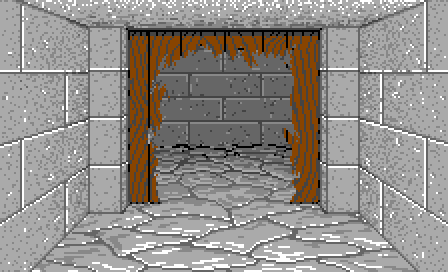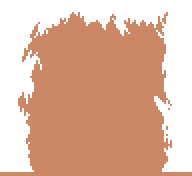Downloads
Executable for the map editor (Windows 32bits)
Executable for the game (Windows 32bits)
Before you try to compile the code go to the "Projects" tab on the left menu, select the "Run" settings for your kit,
and set the "Working directory" to the path of "editor\data" for the editor or "game\data" for the game.
Door 22

At the beginning it is opened, but when we approach it, an invisible switch closes it. Then, the only way to open it is to smash it with our weapons.

At first I thought to use the "isOpened" flag to display this state, but as the door first slides down from the
ceiling to close itself, there must be a "isBroken" state separate from the "isOpened" one. So we must add this to "tiles.cpp".
<tile name="Door">
[...]
<param type="bool">isBroken</param>
</tile>
Converting maps
In the editor there is a define called "CONVERT_MAP" that is normally commented.
//#define CONVERT_MAP 1
The load() function:
void CBridge::load(QString fileName)
{
//trick to convert old map formats
#ifdef CONVERT_MAP
CMap::mTilesParams.clear();
editor.readTilesDB("databases/tiles-old.xml");
// CMap::mWallsParams.clear();
// editor.readWallsDB("databases/walls-old.xml");
// CMap::mObjectsParams.clear();
// editor.readObjectsDB("databases/items-old.xml");
#endif
// [8] to remove "file:///"
map.load(&fileName.toLocal8Bit().data()[8]);
updateQMLImage();
}
void CBridge::save(QString fileName)
{
//trick to convert old map formats
#ifdef CONVERT_MAP
CMap::mTilesParams.clear();
editor.readTilesDB("databases/tiles.xml");
// CMap::mWallsParams.clear();
// editor.readWallsDB("databases/walls.xml");
// CMap::mObjectsParams.clear();
// editor.readObjectsDB("databases/items.xml");
#endif
// [8] to remove "file:///"
map.save(&fileName.toLocal8Bit().data()[8]);
}
part, without our new parameter.
The save() function will load the current file, with the new parameter.
So to convert a map to take into account this new parameter, you will need to have two the versons of "tiles.xml"
in the database directory.
Then un-comment the "CONVERT_MAP" define, re-compile the editor and launch it.
Load the map you want to convert and save it again.
To check if the conversion worked, re-compile the editor with the "CONVERT_MAP" define commented out and try to
reload the map.
As the conversion only checks the number of parameters of a given tile type, the new parameters can only be added
at the end of the existing ones.
They will get a default value when you save the map (false for booleans, 0 for integers, ...).
Drawing the broken door

We could draw it the same way as we did for the ornates by first drawing it over the door image and then "removing"
the pink pixels, but the composition modes of Qt allows us to turn the pixels transparent directly, using this
image as a mask.
void CGraphics2D::drawImageTransparent(QImage* destImage, const CVec2& pos, const QImage& srcImage)
{
QPainter painter(destImage);
painter.setCompositionMode(QPainter::CompositionMode_DestinationOut);
painter.drawImage(pos.x, pos.y, srcImage);
painter.end();
}
void CDoors::drawDoor(QImage* image, CVec2 tablePos, CTile* tile)
{
[...]
// breakable door
if (tile->getBoolParam("isBreakable") == true && tile->getBoolParam("isBroken") == true)
{
QImage holeImage = fileCache.getImage(std::string("gfx/3DView/doors/Bashed_Door.png"));
graph2D.drawImageTransparent(&doorImage, CVec2(), holeImage);
}
Only a few attacks can break the door.
So in CInterface::updateWeapons(), when we detect that there is a breakable door in front of us and when the current
attack is one of the wanted types, we set the "isBroken" flag to true.
void CInterface::updateWeapons()
{
// attack highlight
if (attackHighlightTime.update() == true)
{
[...]
CVec2 frontPos = player.getPosFromLocal(CVec2(0, -1));
CTile* frontTile = map.getTile(frontPos);
if (frontTile != NULL)
{
// breakble door
if (frontTile->getType() == eTileDoor &&
frontTile->getBoolParam("isBreakable") == true &&
frontTile->getBoolParam("isBroken") == false &&
(attackType == ATTACK_CHOP ||
attackType == ATTACK_KICK ||
attackType == ATTACK_SWING ||
attackType == ATTACK_HACK ||
attackType == ATTACK_BERZERK ||
attackType == ATTACK_BASH)
)
{
frontTile->setBoolParam("isBroken", true);
weaponCoolDown[currentWeapon].set(60, true);
sound->play(frontPos, "sound/Wooden_Thud.wav");
}
else
{
// normal hit
[...]
}
}
I didn't include this because most of the time you will have the right weapon to break the door at a given level.
When I looked at the code of the original game, I noticed that some doors could be broken with a fireball, but I
never saw anybody do this.
We also have to change the isOpened() function so that broken doors are considered as opened and we can walk
through them:
bool CDoors::isOpened(CTile* tile)
{
bool isOpened = tile->getBoolParam("isOpened") || tile->getBoolParam("isBroken");
bool isMoving = tile->getBoolParam("isMoving");
if (isOpened == true && isMoving == false)
return true;
else
return false;
}
And we defined all the pressure plates too.